Evolution of Management Theory & Practice: A Comprehensive Analysis
VerifiedAdded on 2023/01/13
|8
|2664
|90
Report
AI Summary
This report provides a detailed overview of the evolution of management theory and practice. It begins by examining pre-industrial management practices, highlighting the limited emphasis on commerce and enterprise. The report then delves into the improvements in management practices during the industrial revolution, focusing on scientific management principles, including the contributions of Taylor, Gilbreth, and Gantt. It analyzes the growing sophistication of management in the post-industrial era, emphasizing the shift towards employee self-management and the impact of technological advancements and globalization. The report also discusses the developing changes in current and future management practices, offering a comprehensive understanding of the subject. The report covers the shift in management practices over time, exploring the influence of economists, industrialization, and technological advancements on organizational environments. It provides a comprehensive understanding of the subject.
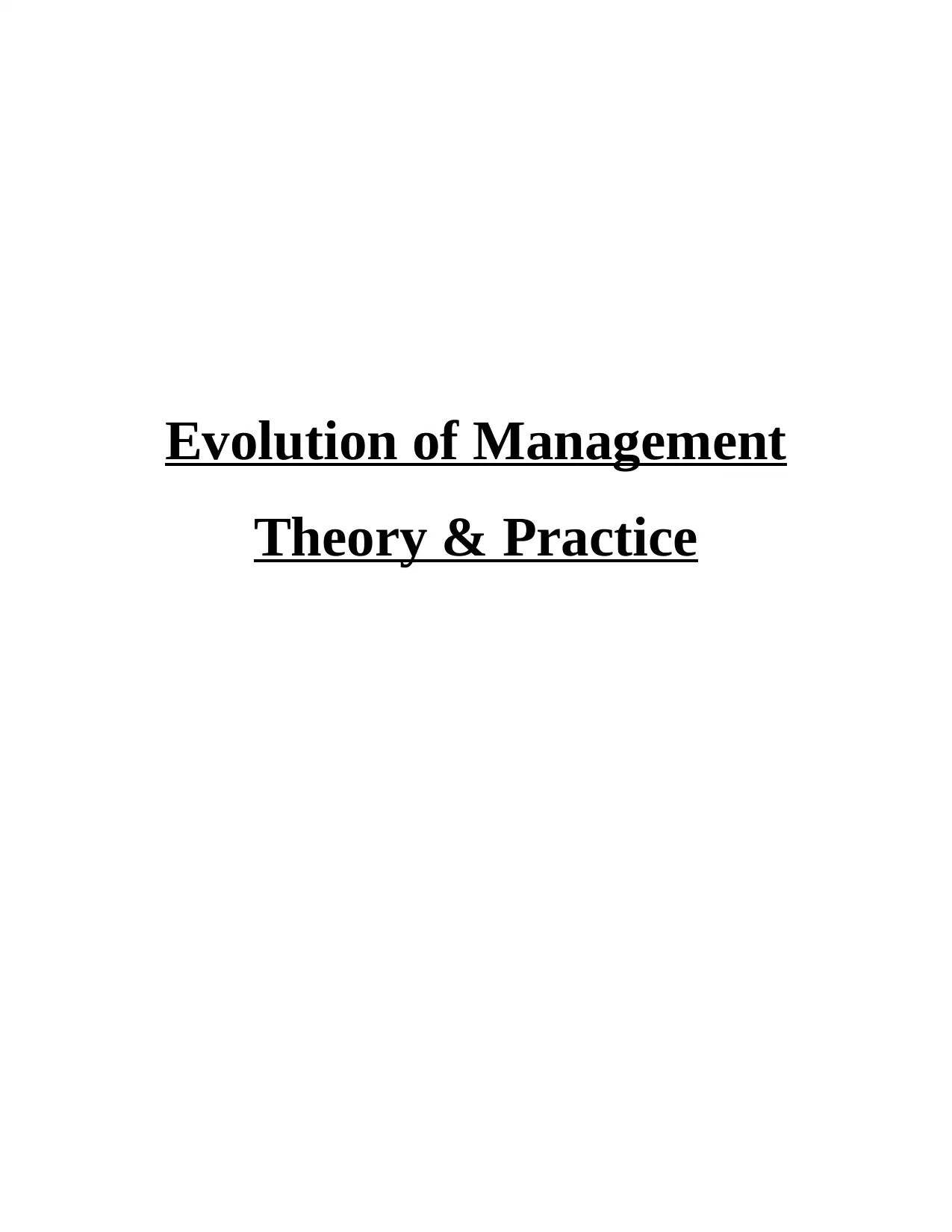
Evolution of Management
Theory & Practice
Theory & Practice
Paraphrase This Document
Need a fresh take? Get an instant paraphrase of this document with our AI Paraphraser
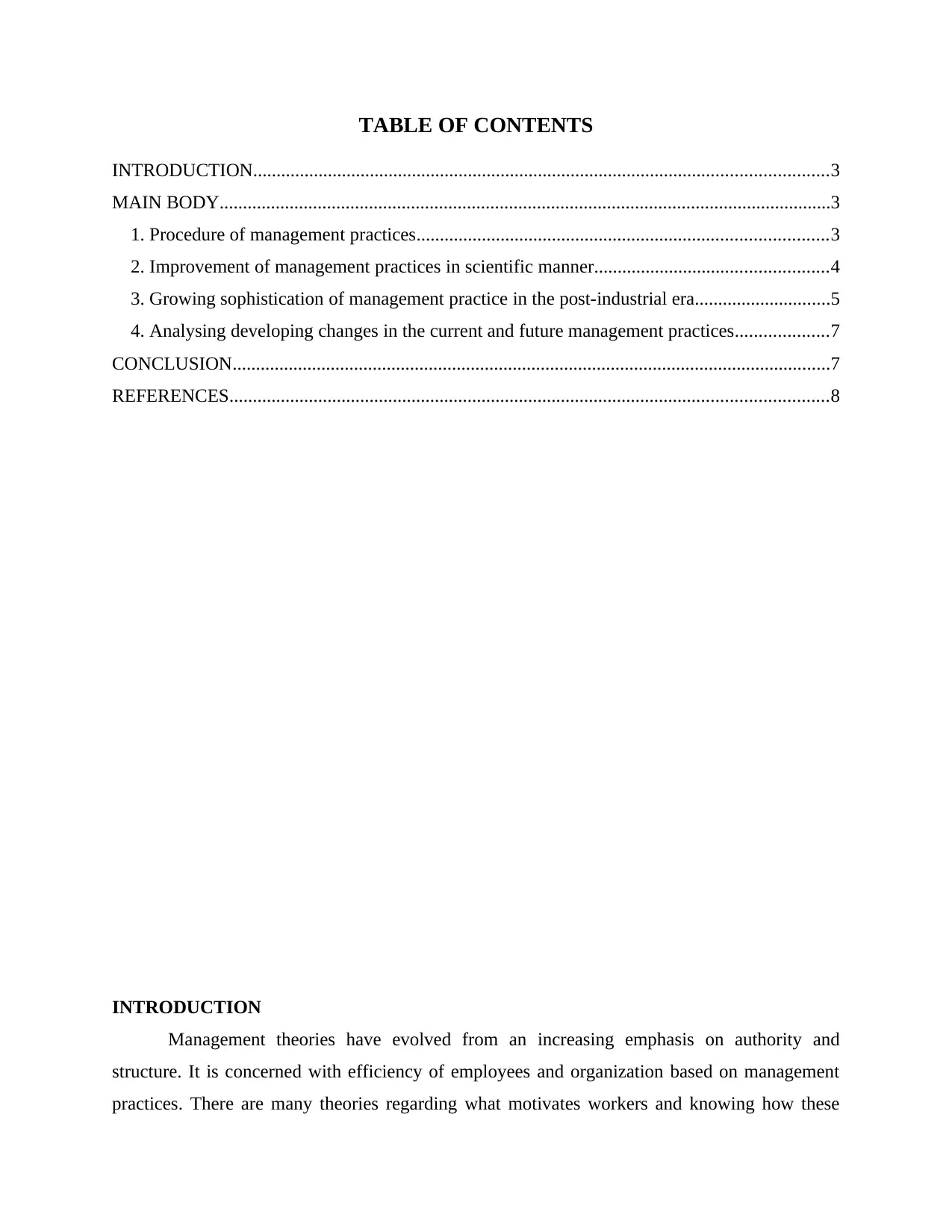
TABLE OF CONTENTS
INTRODUCTION...........................................................................................................................3
MAIN BODY...................................................................................................................................3
1. Procedure of management practices........................................................................................3
2. Improvement of management practices in scientific manner..................................................4
3. Growing sophistication of management practice in the post-industrial era.............................5
4. Analysing developing changes in the current and future management practices....................7
CONCLUSION................................................................................................................................7
REFERENCES................................................................................................................................8
INTRODUCTION
Management theories have evolved from an increasing emphasis on authority and
structure. It is concerned with efficiency of employees and organization based on management
practices. There are many theories regarding what motivates workers and knowing how these
INTRODUCTION...........................................................................................................................3
MAIN BODY...................................................................................................................................3
1. Procedure of management practices........................................................................................3
2. Improvement of management practices in scientific manner..................................................4
3. Growing sophistication of management practice in the post-industrial era.............................5
4. Analysing developing changes in the current and future management practices....................7
CONCLUSION................................................................................................................................7
REFERENCES................................................................................................................................8
INTRODUCTION
Management theories have evolved from an increasing emphasis on authority and
structure. It is concerned with efficiency of employees and organization based on management
practices. There are many theories regarding what motivates workers and knowing how these
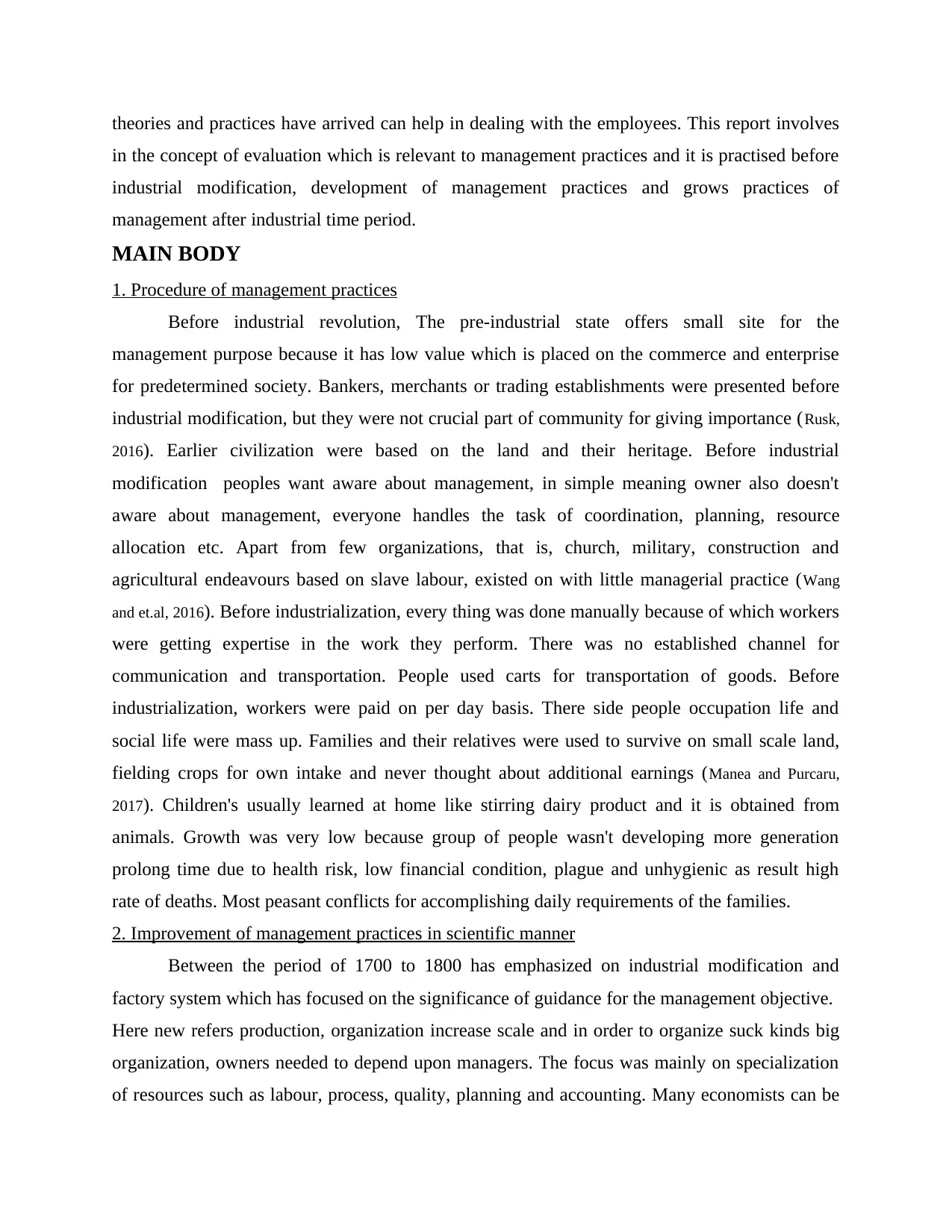
theories and practices have arrived can help in dealing with the employees. This report involves
in the concept of evaluation which is relevant to management practices and it is practised before
industrial modification, development of management practices and grows practices of
management after industrial time period.
MAIN BODY
1. Procedure of management practices
Before industrial revolution, The pre-industrial state offers small site for the
management purpose because it has low value which is placed on the commerce and enterprise
for predetermined society. Bankers, merchants or trading establishments were presented before
industrial modification, but they were not crucial part of community for giving importance (Rusk,
2016). Earlier civilization were based on the land and their heritage. Before industrial
modification peoples want aware about management, in simple meaning owner also doesn't
aware about management, everyone handles the task of coordination, planning, resource
allocation etc. Apart from few organizations, that is, church, military, construction and
agricultural endeavours based on slave labour, existed on with little managerial practice (Wang
and et.al, 2016). Before industrialization, every thing was done manually because of which workers
were getting expertise in the work they perform. There was no established channel for
communication and transportation. People used carts for transportation of goods. Before
industrialization, workers were paid on per day basis. There side people occupation life and
social life were mass up. Families and their relatives were used to survive on small scale land,
fielding crops for own intake and never thought about additional earnings (Manea and Purcaru,
2017). Children's usually learned at home like stirring dairy product and it is obtained from
animals. Growth was very low because group of people wasn't developing more generation
prolong time due to health risk, low financial condition, plague and unhygienic as result high
rate of deaths. Most peasant conflicts for accomplishing daily requirements of the families.
2. Improvement of management practices in scientific manner
Between the period of 1700 to 1800 has emphasized on industrial modification and
factory system which has focused on the significance of guidance for the management objective.
Here new refers production, organization increase scale and in order to organize suck kinds big
organization, owners needed to depend upon managers. The focus was mainly on specialization
of resources such as labour, process, quality, planning and accounting. Many economists can be
in the concept of evaluation which is relevant to management practices and it is practised before
industrial modification, development of management practices and grows practices of
management after industrial time period.
MAIN BODY
1. Procedure of management practices
Before industrial revolution, The pre-industrial state offers small site for the
management purpose because it has low value which is placed on the commerce and enterprise
for predetermined society. Bankers, merchants or trading establishments were presented before
industrial modification, but they were not crucial part of community for giving importance (Rusk,
2016). Earlier civilization were based on the land and their heritage. Before industrial
modification peoples want aware about management, in simple meaning owner also doesn't
aware about management, everyone handles the task of coordination, planning, resource
allocation etc. Apart from few organizations, that is, church, military, construction and
agricultural endeavours based on slave labour, existed on with little managerial practice (Wang
and et.al, 2016). Before industrialization, every thing was done manually because of which workers
were getting expertise in the work they perform. There was no established channel for
communication and transportation. People used carts for transportation of goods. Before
industrialization, workers were paid on per day basis. There side people occupation life and
social life were mass up. Families and their relatives were used to survive on small scale land,
fielding crops for own intake and never thought about additional earnings (Manea and Purcaru,
2017). Children's usually learned at home like stirring dairy product and it is obtained from
animals. Growth was very low because group of people wasn't developing more generation
prolong time due to health risk, low financial condition, plague and unhygienic as result high
rate of deaths. Most peasant conflicts for accomplishing daily requirements of the families.
2. Improvement of management practices in scientific manner
Between the period of 1700 to 1800 has emphasized on industrial modification and
factory system which has focused on the significance of guidance for the management objective.
Here new refers production, organization increase scale and in order to organize suck kinds big
organization, owners needed to depend upon managers. The focus was mainly on specialization
of resources such as labour, process, quality, planning and accounting. Many economists can be
⊘ This is a preview!⊘
Do you want full access?
Subscribe today to unlock all pages.

Trusted by 1+ million students worldwide
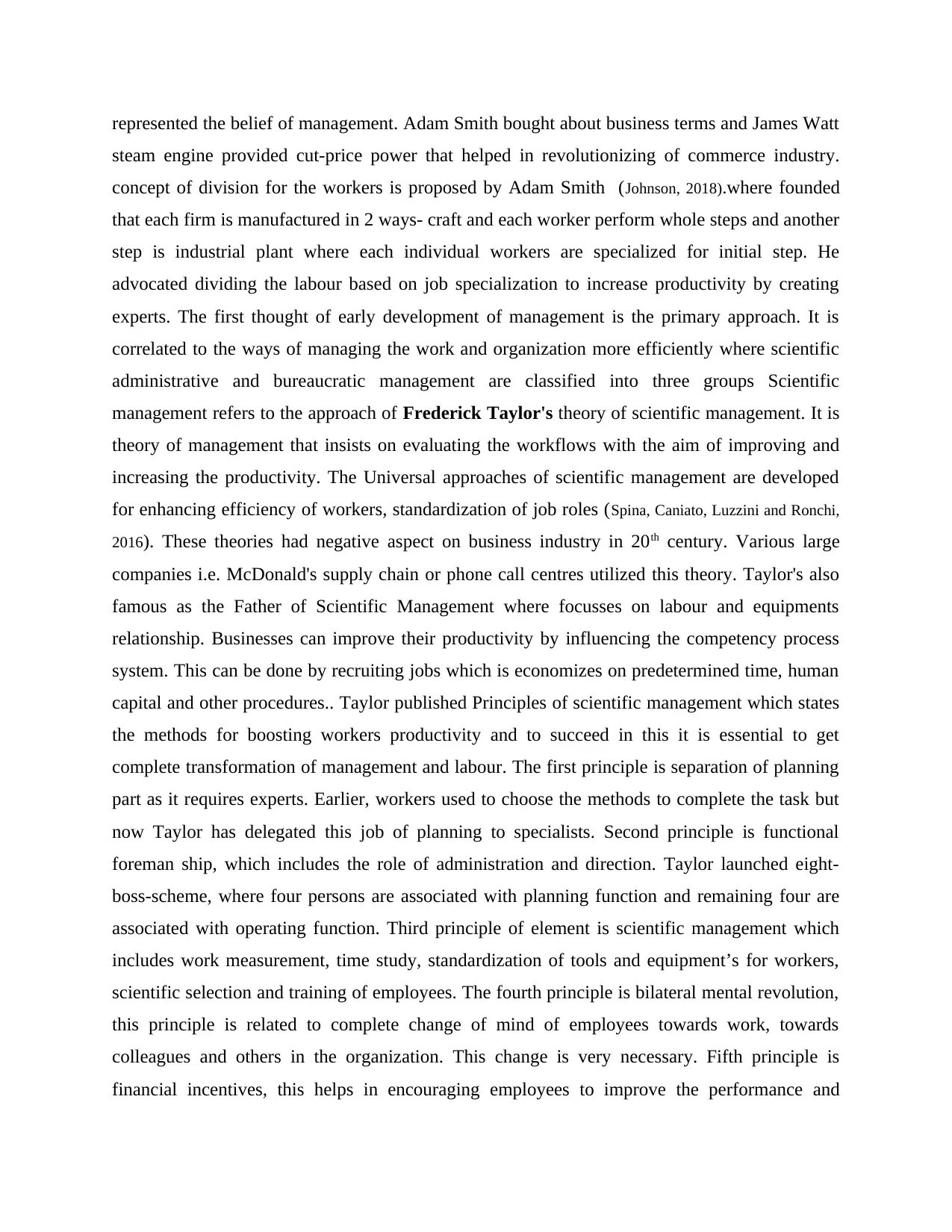
represented the belief of management. Adam Smith bought about business terms and James Watt
steam engine provided cut-price power that helped in revolutionizing of commerce industry.
concept of division for the workers is proposed by Adam Smith (Johnson, 2018).where founded
that each firm is manufactured in 2 ways- craft and each worker perform whole steps and another
step is industrial plant where each individual workers are specialized for initial step. He
advocated dividing the labour based on job specialization to increase productivity by creating
experts. The first thought of early development of management is the primary approach. It is
correlated to the ways of managing the work and organization more efficiently where scientific
administrative and bureaucratic management are classified into three groups Scientific
management refers to the approach of Frederick Taylor's theory of scientific management. It is
theory of management that insists on evaluating the workflows with the aim of improving and
increasing the productivity. The Universal approaches of scientific management are developed
for enhancing efficiency of workers, standardization of job roles (Spina, Caniato, Luzzini and Ronchi,
2016). These theories had negative aspect on business industry in 20th century. Various large
companies i.e. McDonald's supply chain or phone call centres utilized this theory. Taylor's also
famous as the Father of Scientific Management where focusses on labour and equipments
relationship. Businesses can improve their productivity by influencing the competency process
system. This can be done by recruiting jobs which is economizes on predetermined time, human
capital and other procedures.. Taylor published Principles of scientific management which states
the methods for boosting workers productivity and to succeed in this it is essential to get
complete transformation of management and labour. The first principle is separation of planning
part as it requires experts. Earlier, workers used to choose the methods to complete the task but
now Taylor has delegated this job of planning to specialists. Second principle is functional
foreman ship, which includes the role of administration and direction. Taylor launched eight-
boss-scheme, where four persons are associated with planning function and remaining four are
associated with operating function. Third principle of element is scientific management which
includes work measurement, time study, standardization of tools and equipment’s for workers,
scientific selection and training of employees. The fourth principle is bilateral mental revolution,
this principle is related to complete change of mind of employees towards work, towards
colleagues and others in the organization. This change is very necessary. Fifth principle is
financial incentives, this helps in encouraging employees to improve the performance and
steam engine provided cut-price power that helped in revolutionizing of commerce industry.
concept of division for the workers is proposed by Adam Smith (Johnson, 2018).where founded
that each firm is manufactured in 2 ways- craft and each worker perform whole steps and another
step is industrial plant where each individual workers are specialized for initial step. He
advocated dividing the labour based on job specialization to increase productivity by creating
experts. The first thought of early development of management is the primary approach. It is
correlated to the ways of managing the work and organization more efficiently where scientific
administrative and bureaucratic management are classified into three groups Scientific
management refers to the approach of Frederick Taylor's theory of scientific management. It is
theory of management that insists on evaluating the workflows with the aim of improving and
increasing the productivity. The Universal approaches of scientific management are developed
for enhancing efficiency of workers, standardization of job roles (Spina, Caniato, Luzzini and Ronchi,
2016). These theories had negative aspect on business industry in 20th century. Various large
companies i.e. McDonald's supply chain or phone call centres utilized this theory. Taylor's also
famous as the Father of Scientific Management where focusses on labour and equipments
relationship. Businesses can improve their productivity by influencing the competency process
system. This can be done by recruiting jobs which is economizes on predetermined time, human
capital and other procedures.. Taylor published Principles of scientific management which states
the methods for boosting workers productivity and to succeed in this it is essential to get
complete transformation of management and labour. The first principle is separation of planning
part as it requires experts. Earlier, workers used to choose the methods to complete the task but
now Taylor has delegated this job of planning to specialists. Second principle is functional
foreman ship, which includes the role of administration and direction. Taylor launched eight-
boss-scheme, where four persons are associated with planning function and remaining four are
associated with operating function. Third principle of element is scientific management which
includes work measurement, time study, standardization of tools and equipment’s for workers,
scientific selection and training of employees. The fourth principle is bilateral mental revolution,
this principle is related to complete change of mind of employees towards work, towards
colleagues and others in the organization. This change is very necessary. Fifth principle is
financial incentives, this helps in encouraging employees to improve the performance and
Paraphrase This Document
Need a fresh take? Get an instant paraphrase of this document with our AI Paraphraser

productivity. Taylor introduced a wage system known as differential piece rate system, which is
based on the individual performance. Economy is the another principle devised by Taylor. As per
this principle, through division of labour and specialization, maximum output can be achieved.
These scientific principles concentrate on technical as well as profits. Other than Taylor, Frank
Gilbreth, was interested in workers productivity and how the motion affected the efficiency.
Gilbreth used films to analyse worker activity. He divided the task into different elements and
movement and then recorded the time within which each element is completed. So, in this way
he was able to identify the most efficient way to do a particular task. The films that Gilbreth
made were used in providing training instructing employees how to work efficiently. Both
Taylor and Gilbreth belonged to classical school of management. They believed that if number
of motions related to particular job is reduced, then this will help in increasing the employee
well-being and performance. The research of both Taylor and Gilbreth incorporated into quality
assurance and quality control. Henry Gantt was best known for its contribution to classical
management theory, That is, the Gantt chart, the task, and bonus system (Liwen, 2016). The Gantt
chart provides a visual representation of what occurred in the course of a task. It identifies the
task and assigns the estimated time to complete the task, and an initial date for each task. It has
several benefits, first it breaks down the tasks into several elements, allows monitoring of
elements and in identifying which task is dependent upon other task. Gantt also has task and
bonus plan, opposite of Taylor's differential piece wage system. Gantt established a standard
time for a particular task. If a worker performs below it, his pay is locked and if he performs
above the standard then gets he bonus upto 20% more.
3. Growing sophistication of management practice in the post-industrial era
Industrial age organizations were based on roles assigned to employees, putting powers
in the hands of managers and making management a top-down function. Today, management is
much more than what managers usually do earlier. In modern, post-industrial organizations,
employees needs to manage themselves (Obitade, 2019). Management is closely linked to
achievement of objectives. After industrial revolution, farmers and other people moved to cities
where industrial mills and factories are booming creating job opportunity. Schools are now more
focussed on timekeeping and preparing children . After industrialization, significant changes
taken place. It established proper communication channel in the form of telephone, improved
roads system etc. Post industrial era means in sociology is that the society attains the stage in
based on the individual performance. Economy is the another principle devised by Taylor. As per
this principle, through division of labour and specialization, maximum output can be achieved.
These scientific principles concentrate on technical as well as profits. Other than Taylor, Frank
Gilbreth, was interested in workers productivity and how the motion affected the efficiency.
Gilbreth used films to analyse worker activity. He divided the task into different elements and
movement and then recorded the time within which each element is completed. So, in this way
he was able to identify the most efficient way to do a particular task. The films that Gilbreth
made were used in providing training instructing employees how to work efficiently. Both
Taylor and Gilbreth belonged to classical school of management. They believed that if number
of motions related to particular job is reduced, then this will help in increasing the employee
well-being and performance. The research of both Taylor and Gilbreth incorporated into quality
assurance and quality control. Henry Gantt was best known for its contribution to classical
management theory, That is, the Gantt chart, the task, and bonus system (Liwen, 2016). The Gantt
chart provides a visual representation of what occurred in the course of a task. It identifies the
task and assigns the estimated time to complete the task, and an initial date for each task. It has
several benefits, first it breaks down the tasks into several elements, allows monitoring of
elements and in identifying which task is dependent upon other task. Gantt also has task and
bonus plan, opposite of Taylor's differential piece wage system. Gantt established a standard
time for a particular task. If a worker performs below it, his pay is locked and if he performs
above the standard then gets he bonus upto 20% more.
3. Growing sophistication of management practice in the post-industrial era
Industrial age organizations were based on roles assigned to employees, putting powers
in the hands of managers and making management a top-down function. Today, management is
much more than what managers usually do earlier. In modern, post-industrial organizations,
employees needs to manage themselves (Obitade, 2019). Management is closely linked to
achievement of objectives. After industrial revolution, farmers and other people moved to cities
where industrial mills and factories are booming creating job opportunity. Schools are now more
focussed on timekeeping and preparing children . After industrialization, significant changes
taken place. It established proper communication channel in the form of telephone, improved
roads system etc. Post industrial era means in sociology is that the society attains the stage in

which the service sector becomes more profitable than the manufacturing industry (Coetzee, 2017).
This basically refers to the development of the economy which follows industrialization which
focuses on the services and intelligences possessed by the people to design and use the
technology for the development of the business. This is gradually expanding in many countries
as the expertise required to use the machineries and technology in this era. During this period of
industrialization, huge expansion is recorded and it needs management practices for managing
them. Post industrial era leads to development of the theories and different concepts, innovation
and change in production techniques takes place (Byrne, 2018). More manager and employees
were appointed to manage the tasks. It enhances the productivity in the industries.
Management practices became sophisticated due to the following reasons: competition is
raised in the market, increment in sales, development of new markets, reducing costs of the
production and generating more profits, improvement in the skills of the employees, using
technology for enhancing the performance, improve in quality of the products, responding to
innovations to take the competitive advantage. So this developed more competitive approaches
in all the business sectors (Waite and et.al., 2018). It encourages to growth the sophisticated
approaches in terms of management practices like people only focus to earn profit and did not
concern about others feelings. As the huge expansion in industrialization took place, it created
various opportunities in for the employment as well but due to partiality and less skilled people,
they did not get opportunities of employed. Also, the business activities are led to another level
which motivates the globalization of the countries. This helps in various senses for the growth of
different regions but also created competition among them in becoming the largest economy in
the world. During post-industrial era it takes growth for the development of the social and
economic conditions of the countries. This leads to higher needs of the labours, land, capital,
technology etc. which helps them to maintain the supply chain. As the new products launched in
the market people have curiosity to buy them, and they give more money for it, which gives
these industries huge profits (Danneyrolles, Arseneault and Bergeron, 2016). So the greed in the
industrialists increased continuously and expanding the business.
These management practices governs to the governmental policies in which they change
their polices and legal structure to support the industry development. They impose import and
export taxation for trading, other legal procedures must be followed by them (Lu, Liu and Wang,
2019). The competitors would not allow the new entrants to do the business so that their profit
This basically refers to the development of the economy which follows industrialization which
focuses on the services and intelligences possessed by the people to design and use the
technology for the development of the business. This is gradually expanding in many countries
as the expertise required to use the machineries and technology in this era. During this period of
industrialization, huge expansion is recorded and it needs management practices for managing
them. Post industrial era leads to development of the theories and different concepts, innovation
and change in production techniques takes place (Byrne, 2018). More manager and employees
were appointed to manage the tasks. It enhances the productivity in the industries.
Management practices became sophisticated due to the following reasons: competition is
raised in the market, increment in sales, development of new markets, reducing costs of the
production and generating more profits, improvement in the skills of the employees, using
technology for enhancing the performance, improve in quality of the products, responding to
innovations to take the competitive advantage. So this developed more competitive approaches
in all the business sectors (Waite and et.al., 2018). It encourages to growth the sophisticated
approaches in terms of management practices like people only focus to earn profit and did not
concern about others feelings. As the huge expansion in industrialization took place, it created
various opportunities in for the employment as well but due to partiality and less skilled people,
they did not get opportunities of employed. Also, the business activities are led to another level
which motivates the globalization of the countries. This helps in various senses for the growth of
different regions but also created competition among them in becoming the largest economy in
the world. During post-industrial era it takes growth for the development of the social and
economic conditions of the countries. This leads to higher needs of the labours, land, capital,
technology etc. which helps them to maintain the supply chain. As the new products launched in
the market people have curiosity to buy them, and they give more money for it, which gives
these industries huge profits (Danneyrolles, Arseneault and Bergeron, 2016). So the greed in the
industrialists increased continuously and expanding the business.
These management practices governs to the governmental policies in which they change
their polices and legal structure to support the industry development. They impose import and
export taxation for trading, other legal procedures must be followed by them (Lu, Liu and Wang,
2019). The competitors would not allow the new entrants to do the business so that their profit
⊘ This is a preview!⊘
Do you want full access?
Subscribe today to unlock all pages.

Trusted by 1+ million students worldwide
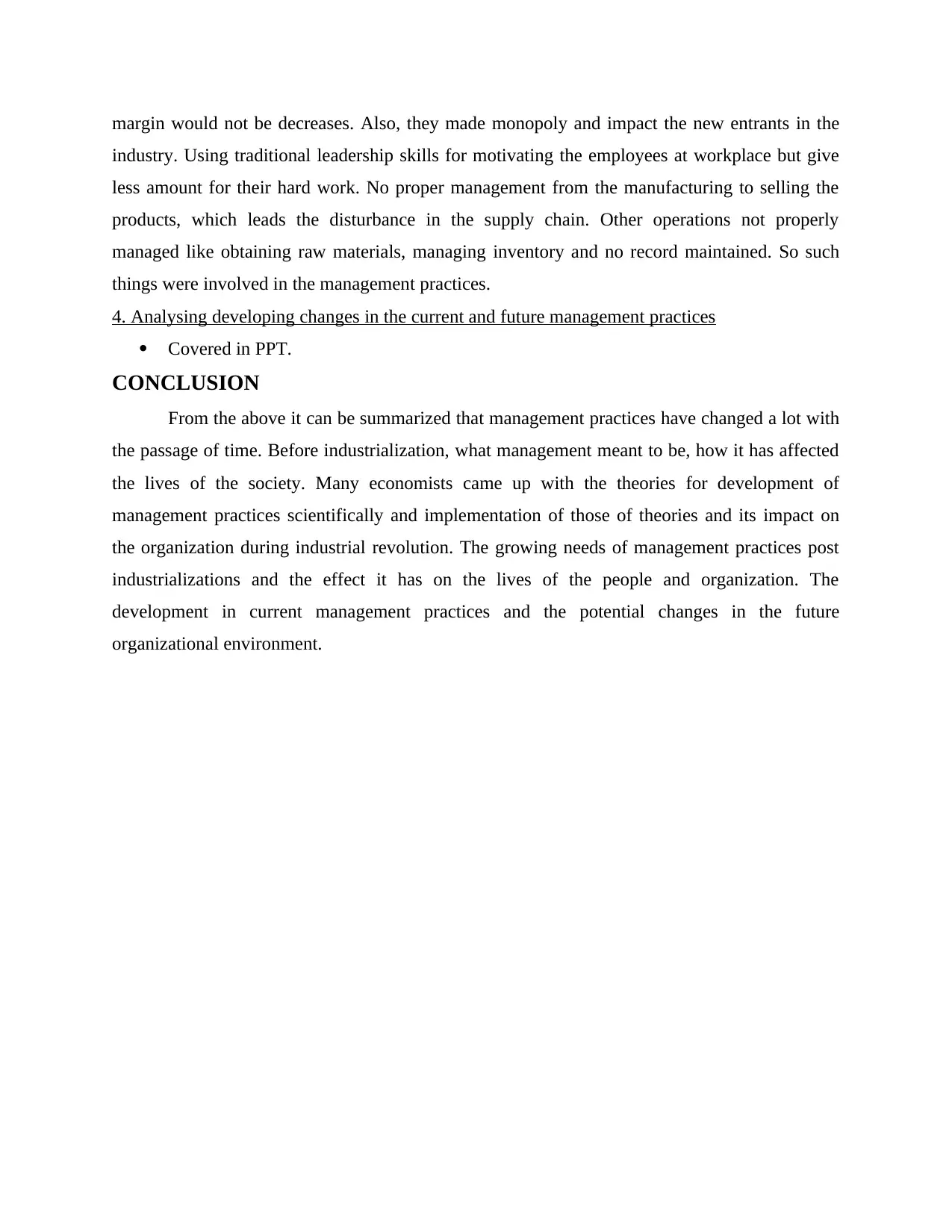
margin would not be decreases. Also, they made monopoly and impact the new entrants in the
industry. Using traditional leadership skills for motivating the employees at workplace but give
less amount for their hard work. No proper management from the manufacturing to selling the
products, which leads the disturbance in the supply chain. Other operations not properly
managed like obtaining raw materials, managing inventory and no record maintained. So such
things were involved in the management practices.
4. Analysing developing changes in the current and future management practices
Covered in PPT.
CONCLUSION
From the above it can be summarized that management practices have changed a lot with
the passage of time. Before industrialization, what management meant to be, how it has affected
the lives of the society. Many economists came up with the theories for development of
management practices scientifically and implementation of those of theories and its impact on
the organization during industrial revolution. The growing needs of management practices post
industrializations and the effect it has on the lives of the people and organization. The
development in current management practices and the potential changes in the future
organizational environment.
industry. Using traditional leadership skills for motivating the employees at workplace but give
less amount for their hard work. No proper management from the manufacturing to selling the
products, which leads the disturbance in the supply chain. Other operations not properly
managed like obtaining raw materials, managing inventory and no record maintained. So such
things were involved in the management practices.
4. Analysing developing changes in the current and future management practices
Covered in PPT.
CONCLUSION
From the above it can be summarized that management practices have changed a lot with
the passage of time. Before industrialization, what management meant to be, how it has affected
the lives of the society. Many economists came up with the theories for development of
management practices scientifically and implementation of those of theories and its impact on
the organization during industrial revolution. The growing needs of management practices post
industrializations and the effect it has on the lives of the people and organization. The
development in current management practices and the potential changes in the future
organizational environment.
Paraphrase This Document
Need a fresh take? Get an instant paraphrase of this document with our AI Paraphraser
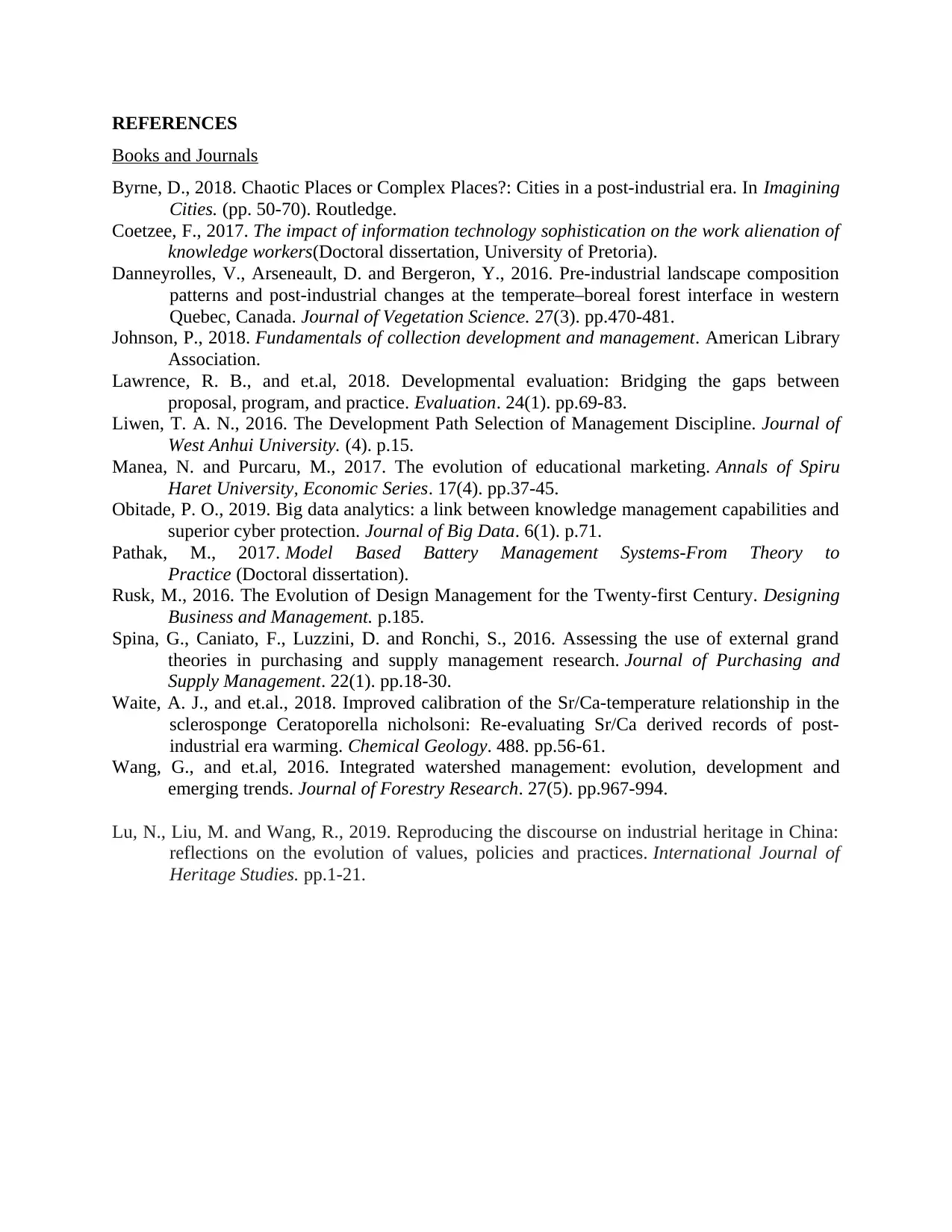
REFERENCES
Books and Journals
Byrne, D., 2018. Chaotic Places or Complex Places?: Cities in a post-industrial era. In Imagining
Cities. (pp. 50-70). Routledge.
Coetzee, F., 2017. The impact of information technology sophistication on the work alienation of
knowledge workers(Doctoral dissertation, University of Pretoria).
Danneyrolles, V., Arseneault, D. and Bergeron, Y., 2016. Pre‐industrial landscape composition
patterns and post‐industrial changes at the temperate–boreal forest interface in western
Quebec, Canada. Journal of Vegetation Science. 27(3). pp.470-481.
Johnson, P., 2018. Fundamentals of collection development and management. American Library
Association.
Lawrence, R. B., and et.al, 2018. Developmental evaluation: Bridging the gaps between
proposal, program, and practice. Evaluation. 24(1). pp.69-83.
Liwen, T. A. N., 2016. The Development Path Selection of Management Discipline. Journal of
West Anhui University. (4). p.15.
Manea, N. and Purcaru, M., 2017. The evolution of educational marketing. Annals of Spiru
Haret University, Economic Series. 17(4). pp.37-45.
Obitade, P. O., 2019. Big data analytics: a link between knowledge management capabilities and
superior cyber protection. Journal of Big Data. 6(1). p.71.
Pathak, M., 2017. Model Based Battery Management Systems-From Theory to
Practice (Doctoral dissertation).
Rusk, M., 2016. The Evolution of Design Management for the Twenty-first Century. Designing
Business and Management. p.185.
Spina, G., Caniato, F., Luzzini, D. and Ronchi, S., 2016. Assessing the use of external grand
theories in purchasing and supply management research. Journal of Purchasing and
Supply Management. 22(1). pp.18-30.
Waite, A. J., and et.al., 2018. Improved calibration of the Sr/Ca-temperature relationship in the
sclerosponge Ceratoporella nicholsoni: Re-evaluating Sr/Ca derived records of post-
industrial era warming. Chemical Geology. 488. pp.56-61.
Wang, G., and et.al, 2016. Integrated watershed management: evolution, development and
emerging trends. Journal of Forestry Research. 27(5). pp.967-994.
Lu, N., Liu, M. and Wang, R., 2019. Reproducing the discourse on industrial heritage in China:
reflections on the evolution of values, policies and practices. International Journal of
Heritage Studies. pp.1-21.
Books and Journals
Byrne, D., 2018. Chaotic Places or Complex Places?: Cities in a post-industrial era. In Imagining
Cities. (pp. 50-70). Routledge.
Coetzee, F., 2017. The impact of information technology sophistication on the work alienation of
knowledge workers(Doctoral dissertation, University of Pretoria).
Danneyrolles, V., Arseneault, D. and Bergeron, Y., 2016. Pre‐industrial landscape composition
patterns and post‐industrial changes at the temperate–boreal forest interface in western
Quebec, Canada. Journal of Vegetation Science. 27(3). pp.470-481.
Johnson, P., 2018. Fundamentals of collection development and management. American Library
Association.
Lawrence, R. B., and et.al, 2018. Developmental evaluation: Bridging the gaps between
proposal, program, and practice. Evaluation. 24(1). pp.69-83.
Liwen, T. A. N., 2016. The Development Path Selection of Management Discipline. Journal of
West Anhui University. (4). p.15.
Manea, N. and Purcaru, M., 2017. The evolution of educational marketing. Annals of Spiru
Haret University, Economic Series. 17(4). pp.37-45.
Obitade, P. O., 2019. Big data analytics: a link between knowledge management capabilities and
superior cyber protection. Journal of Big Data. 6(1). p.71.
Pathak, M., 2017. Model Based Battery Management Systems-From Theory to
Practice (Doctoral dissertation).
Rusk, M., 2016. The Evolution of Design Management for the Twenty-first Century. Designing
Business and Management. p.185.
Spina, G., Caniato, F., Luzzini, D. and Ronchi, S., 2016. Assessing the use of external grand
theories in purchasing and supply management research. Journal of Purchasing and
Supply Management. 22(1). pp.18-30.
Waite, A. J., and et.al., 2018. Improved calibration of the Sr/Ca-temperature relationship in the
sclerosponge Ceratoporella nicholsoni: Re-evaluating Sr/Ca derived records of post-
industrial era warming. Chemical Geology. 488. pp.56-61.
Wang, G., and et.al, 2016. Integrated watershed management: evolution, development and
emerging trends. Journal of Forestry Research. 27(5). pp.967-994.
Lu, N., Liu, M. and Wang, R., 2019. Reproducing the discourse on industrial heritage in China:
reflections on the evolution of values, policies and practices. International Journal of
Heritage Studies. pp.1-21.
1 out of 8
Related Documents
Your All-in-One AI-Powered Toolkit for Academic Success.
+13062052269
info@desklib.com
Available 24*7 on WhatsApp / Email
![[object Object]](/_next/static/media/star-bottom.7253800d.svg)
Unlock your academic potential
Copyright © 2020–2025 A2Z Services. All Rights Reserved. Developed and managed by ZUCOL.





